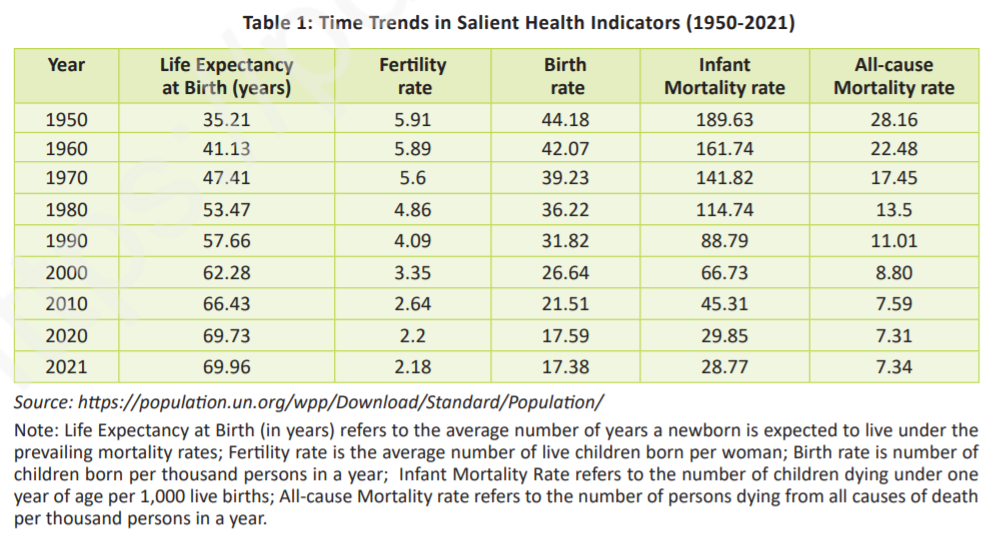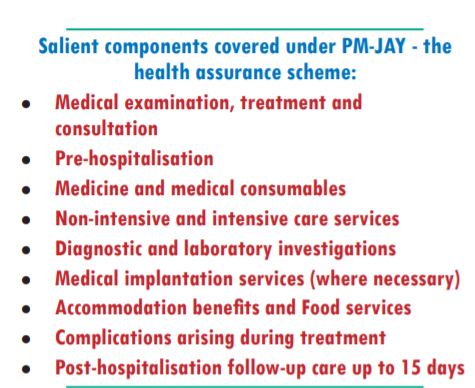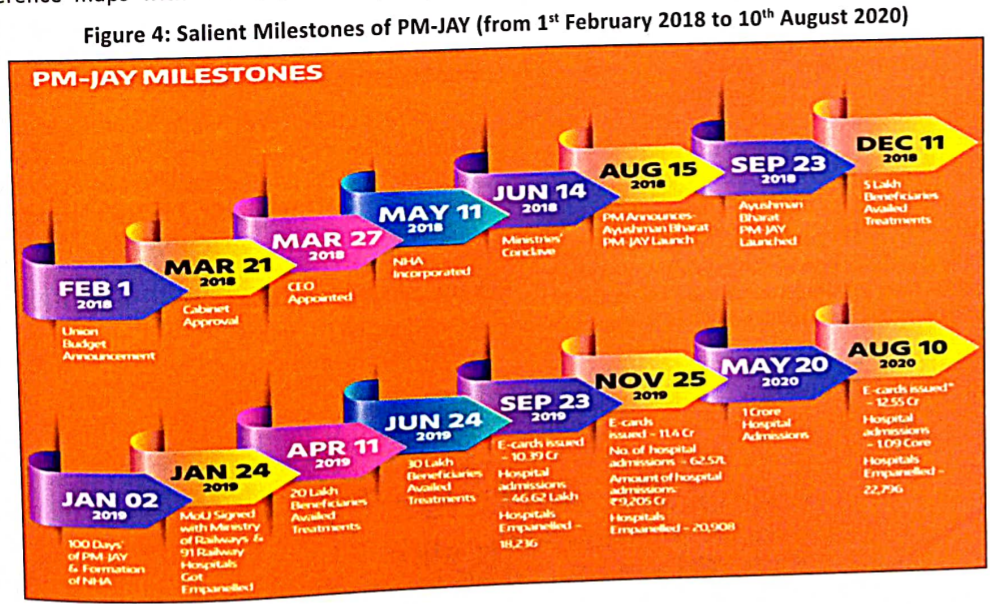ForumIAS announcing GS Foundation Program for UPSC CSE 2025-26 from 19 April. Click Here for more information.
ForumIAS Answer Writing Focus Group (AWFG) for Mains 2024 commencing from 24th June 2024. The Entrance Test for the program will be held on 28th April 2024 at 9 AM. To know more about the program visit: https://forumias.com/blog/awfg2024
Contents
- 1 Introduction
- 2 What is Universal Health Coverage?
- 3 How has the concept of Universal Health Coverage evolved at the global level?
- 4 The concept of universal health coverage in India
- 5 About the Ayushman Bharat Scheme
- 6 What have been the achievements of the Ayushman Bharat scheme since its inception?
- 7 What further steps are required to provide UHC in India?
| For 7PM Editorial Archives click HERE → |
Introduction
According to the World Health Organization (WHO), attaining the highest possible standard of health is a fundamental right of every human being. For achieving the targets of Universal Health Coverage, the Government of India has implemented a flagship public health scheme – ‘Ayushman Bharat’.
What is Universal Health Coverage?
According to the World Health Organization, Universal Health Coverage includes the full spectrum of essential quality health services – from health promotion to prevention, treatment, rehabilitation, and palliative care across the life span. It aims to reduce morbidity and mortality by facilitating easy, economical and secure access to good quality health services to the masses.
| Read more: PM ABHIM (Ayushman Bharat Health Infrastructure Mission) – Explained pointwise |
How has the concept of Universal Health Coverage evolved at the global level?
At the global level, the Alma-Ata Declaration (1978) had emerged as a major milestone in the field of public health. It had identified primary health care as the key for attaining the goal of ‘Health for All’ by the year 2000 AD.
Thereafter, commitments set in the Millennium Declaration had led to the formulation of Millennium Development Goals (MDGs). Three MDGs-4, 5 and 6 directly addressed the health-related issues.
In 2015, UN General Assembly launched the Sustainable Development Goals (SDGs). Of these, the SDG-3 addresses health directly while the SDG-2, SDG-6 and SDG-5 address health indirectly.
The 40th anniversary of Alma-Ata Declaration (Alma-Ata at 40: from 1978 – 2018) came at a time when Primary Health Care is once again receiving well-deserved attention.
However, the Astana Declaration (2018) is a shift from Alma-Ata (Primary Health Care) towards Universal Health Coverage (UHC) for attaining sustainable development goals.
To meet the SDGs targets, nations across the globe are trying to achieve UHC with a focus on its three major pillars: (1) Service Delivery, (2) Health Financing, (3) Governance.
| Read more: Ayushman Bharat Digital Health Mission – Explained, pointwise |
The concept of universal health coverage in India

The concept of universal health coverage (UHC) is not new to India, it was first proposed by the Bhore Committee in 1946 highlighting that all individuals and communities should receive the health services they need without any economic stress. The Committee recommended the integration of preventive and curative services at all levels and laid out a plan for strengthening primary healthcare.
During the post-independence to pre-pandemic period, India was making good progress in terms of scaling up its national health and nutrition services.
The COVID-19 has tested the strengths and weaknesses of the Indian health sector including risk identification, risk assessment and risk alertness which are important components of a surveillance system.
A comparison of the data pertaining to some salient health indicators over a period of 70 years (1950-2021) indicates India is moving towards UHC. For instance, (1) The life expectancy at birth has nearly doubled; (2) There is a reduction in the fertility rate (by ~2.7 folds), birth rate (by >2.5 folds), infant mortality (by ~6.6 folds) and all-cause mortality rate (by ~3.8 folds).
Despite the favourable trends, a lot more is yet to be achieved to improve the health status of our people.
About the Ayushman Bharat Scheme
This scheme was formulated and implemented based on the recommendations of the National Health Policy. It is envisaged that this initiative will help India in achieving the Sustainable Development Goals (SDGs); its mandate is “leave no one behind.” The scheme is under the Ministry of Health and Family Welfare.
Aim: (1) To holistically address the healthcare system-covering prevention, promotion and ambulatory care at all levels – primary, secondary and tertiary, (2) To enhance the quality, efficiency and efficacy of healthcare delivery.
Ayushman Bharat has two major components namely: (1) Health and Wellness Centres (HWCs) and (2) Pradhan Mantri Jan Arogya Yojana (PM-JAY).
| Read more: Critical evaluation of ayushman bharat |
About HWCs
Under this, 1.5 lakh health care centres will be established. The major objective of HWCs would be to provide Comprehensive Primary Health Care (CPHC) closer to the residence/vicinity of the people.
These centres would particularly aim at providing maternal and child health services, along with the delivery of health services for major non-communicable diseases. These centres will also provide free essential drugs and diagnostic services.
| Read more: Govt launches school health programme under Ayushman Bharat |
About PM- Jan Arogya Yojana (PM-JAY)
The scheme aims to provide health cover of Rs. 5 lakhs per family per year for secondary and tertiary care hospitalization to over 10.74 crores of poor and vulnerable families (approximately 50 crore beneficiaries) from the bottom 40% of the Indian population. It is the largest government-funded health assurance scheme in the world.

National Health Authority is the apex body responsible for implementing ‘PM-JAY’.
Salient features of the scheme are
-The annual benefits of Rs. 5 Lakh can be used by any one or more members of the family covering up to all the members.
-There is no capping on family size or age of the family members. In addition, pre-existing diseases are also covered from the very first day.
-It covers up to 3 days of pre-hospitalisation and 15 days post-hospitalisation expenses incurred on diagnostics and medicines.
-Public hospitals are reimbursed for the healthcare services at par with the private hospitals.
| Read more: Union Minister launches Arogya Dhara 2.0 to increase reach of Ayushman Bharat |
What have been the achievements of the Ayushman Bharat scheme since its inception?

Since its inception, Ayushman Bharat has been trying to successfully meet its objectives of ensuring comprehensive coverage for catastrophic illnesses, reduce catastrophic out-of-pocket expenditure, improving access to hospitalisation/health care, reducing unmet needs, and converging various health insurance schemes across the different states of India.
By December 2021, more than 17.3 crore Ayushman Cards had been issued to the beneficiaries. Data indicate that of these, more than 2.6 crore individuals were admitted to the hospitals and 8.3 lakh COVID-19 cases have been treated successfully. Ayushman Bharat has also facilitated the successful implementation of the COVID-19 vaccination drive.
Several notable achievements have been observed in various Indian states/Union Territories like Jammu & Kashmir, Madhya Pradesh to name a few e.g., the Government of J&K has decided to extend the benefits of AB PMJAY to the entire population through 100% government funding mechanism and launched the Universal Health Coverage (AB PM-JAY SEHAT).
| Read more: Govt to rationalise rates of health benefit packages under Ayushman Bharat |
What further steps are required to provide UHC in India?
There is a need to develop a need-specific Framework of Action keeping in mind the following aspects:
Finance: (a) Increase domestic resource mobilisation and budget re-allocation at frequent intervals, (b) Facilitate efficient and judicious time-bound utilisation of financial resources.
Health Services: (a) Prioritise health services which are of most significances to reducing mortality and morbidity, (b) Invest in pre-service medical and paramedical education, (c) Engage in multi-sectoral partnerships to address determinants of health.
Equity: (a) Scale-up safety net approaches including vouchers and conditional cash-transfers which directly or indirectly support good health and well being, (b) Expand service delivery for marginalised and vulnerable groups.
Preparedness: (a) Prepare and regularly improve National preparedness plans especially for natural disasters, (b) Enhance State level and international collaborations to prepare for and respond to public health emergencies such as epidemics/pandemics.
Governance: (a) Ensure that all citizens have access to data and information on UHC, (b) Strengthen national institutions and organisations through capacity building, (c) Ensure workable effective mechanisms for inter-sectoral dialogue and work.
| Read more: “Apart from curing, Ayushman Bharat Scheme is empowering several Indians.” |
Further efforts should be made to provide the benefits of the Ayushman Bharat scheme to the entire population through 100% Government funding like in Jammu and Kashmir. This will make India strong by ensuring good health of people irrespective of their class, creed, gender and socio-economic status.




